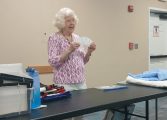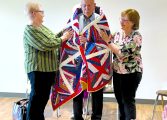By Page H. Gifford, Correspondent
During the monthly meeting of the Fluvanna Art Association (FAA) Friday (July 20), watercolor artist William Snow discussed more advanced techniques and how to achieve creating light and shadow in watercolor.
Considered one of the most difficult mediums to control, watercolor is made to look easy by artists like Snow. But, as with anything, to become skilled at watercolor artists must practice. Many artists reiterate the same basic practices in order to achieve this goal.
When creating shadows, every artist has his or her own method. Some use black and some, like Snow, prefer to use indigo or ultramarine blue and pull it into the color with the shadows. A lot of art is exploring and experimentation, and many novice artists are afraid of going beyond the boundaries of strict teaching. Snow embraces the basics but also understands boundaries can be limiting if an artist is afraid to try anything new or to loosen up.
He described his method of dealing with light and shadows in a still life he had painted and recreated for the group. The painting featured a dark background with reflections on a pewter tanker and a bowl of fruit. A color wheel is an invaluable tool when it comes to creating light and shadows, and Snow uses these methods to his advantage. While he used mostly oranges in the fruit, he used raw and burnt sienna to begin mid-tone shadows and the opposite deeper color for a full shadow.
Member Deborah Nixon asked why watercolor artists work light to dark, unlike other painting, such as acrylics and oils, in which artists work dark to light. Snow explained it is not that easy to correct a mistake or lift out dark color, so that is why watercolor artists begin with pale washes and work their way into building up layers, doing the very dark areas last.
“That means you have to leave some white areas of the paper and work around them. You can use masking to save these areas,” he said. “And put your shadows in last.” He then demonstrated how he begins with an outline of the fruit and draws it with a brush. If he uses too much water, he immediately wipes it up with a brush and dries the brush before picking up more paint. This is a habit of watercolor artists and one technique that should always be practiced until it becomes second nature. It is the key to controlling the water on the paper.
Snow uses larger brushes. On the average he uses numbers 7, 8 and 10, and he also works on a slightly larger scale than most of the members. For backgrounds anything less than an 8 or 10 is futile, he said.
“Don’t be afraid to use bigger brushes,” he said as he swept the burnt sienna and blue to create his mottled background.
Reflections are more of an advanced technique, but once the process is deconstructed it can be mastered with practice.
“Figure where the light areas are and use the lightest colors first and build up,” he said. He added the details on the tanker with a smaller brush and obviously a very steady and patient hand.
He reminded the members that one layer of wash may result in a pure pigment, but that it will dry much lighter. He went in to work other areas while one area was drying. This gives him time to view his work and see where color needs to be laid into painting to make it come alive.
Creating realism in any painting is giving it dimension through its light and dark areas.
“Remember, when a light source is close, the harder the edge; the more diffused lighting is, the edges are softer,” he said. “Also, shadows are not always dark. You will have some color showing through. Shadows have the same colors as the object or objects and its surroundings.”
He wets an area then adds the pigment. To diffuse a shadow, he adds water and pulls it out by wiping it with the brush. “As it begins to dry, pull the color out to emphasize and edge,” he said.
These are slow deliberate moves in painting that cannot be rushed, but Snow, being the pro he is, makes it look effortless.
The buckling of watercolor paper is always a concern to members not familiar with the medium. Snow admitted there will be buckling, particularly with a 140 pound hot pressed paper which does not hold the water as well as a sturdy 300 pound paper or watercolor board.
Snow took a moment while sweeping his brush along the background and blending color, to tell the members that many great artists, including John Singer Sargent, Andrew Wyeth and even Leonardo DaVinci, created duds. Even genius has its moments during creation in which not everything is perfect.




